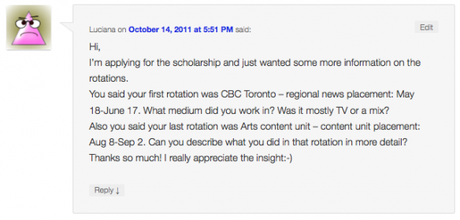
The CBC's Toronto headquarters. (Fabiola Carletti)
Dear readers: My apologies to those of you who aren’t applying for the Joan Donaldson scholarship at the CBC. This post won’t be very interesting to you, so here are cute things falling asleep instead. (Now that has popular appeal!)
So, moving right along: This post started out as a reply to a question beneath my recent post: Thoughts on the Joan Donaldson CBC News Scholarship.

TORONTO REGIONAL PLACEMENT
Luciana asked what medium I worked in most at CBC Toronto. The short answer is television. The long answer is that the CBC is undergoing a sea change toward a more integrated approach to reporting. The walls have literally come down between people working in different mediums. For instance, “radio reporters” are now asked to do live hits for television, or write blog posts, or live tweet at events.
In these times of transition, Donaldsons have a wider range of opportunities. If you’re assertive about what you want to learn, you don’t have to limit yourself to any one platform.
Before me, CBC Toronto had never had a Donaldson intern (because they used to work on news network and other nationally-focused shows. See previous post.) So when I arrived, I was asked what I wanted to do. Here’s what resulted:
- Shadowed Stephanie Matteis on the Jordan Manners trial. Stayed late at the courts on verdict watch and sent updates to the assignment desk via iPhone.
- Spent one week writing television scripts for the anchors under the direction of Alex Sienkiewicz. Also learned to create the text banners and other added value elements you see on your screen (like bullet-point lists, maps, etc).
- Attended all 9:30 a.m. editorial meetings and, most days, stayed until the show was over. I came in early to do this so that I would have a sense of how they chose stories.
- Watched the show from the control room on two occasions.
- Printed and ran scripts to the anchors.
- Listened to police scanners and made calls to push for details on breaking news. Also made calls to fact check and to set up interviews for reporters.
- Learned how to look up items on the internal video vault, DTV. Sometimes we had to get older items “restored.”
- Wrote one radio piece and edited it on Dalet. Also recorded a phone call in studio.
- Shadowed Muhammed Lila on a story about organ donation.
- Stopped people for street interviews re: the Vancouver riot reaction, Air Canada back to work legislation, subway branding, GO bus refunds, etc.
- Conducted an interview for Steven D’Souza’s item on the Book of Negroes
- Gathered clips (short interviews) for the show – including the Scarborough daycare shut down, the McCain funeral, West Nile prevention and the shots heard outside a high school. Also went with camera people to obtain miscellaneous b-roll.
- Went to do an after-hours interview for the Bollywood dance class item with a camera person.
- Provided miscellaneous help to reporters and writers. Ex: transcribing interviews for Genevieve Tomney and Mike Crawley, and tracking down tapes for Nil Köksal.
- Learned to send things through “ingest” (get them on the video editing/viewing system). These visuals came from the internet, FTP sites, cassettes from the visual resources library, etc.
- Compiled a list of lesser-known Toronto attractions for Kimberly Gale.
- On my last day, went to New Market to take notes for John Lancaster. Directed the cameraperson to get shots of the accused’s supporters and gathered clips from the defense lawyer and several students of the accused. Sent John detailed notes after the trial. (And made my way back to Toronto on my own, haha.)
That was all in my first month of the program! Again, I had never done any broadcast journalism before so it was baptism by fire. I didn’t ask to do more radio work or shadow the online reporters because I wanted to experience TV writing/reporting. I felt that I needed to focus on that since I had given it short shrift in j-school.
ARTS UNIT
I spent most of my time with the arts unit doing one of two things:
- I wrote for the arts webpage (both blog posts and news stories), made photo galleries, wrote sidebars, added useful links, and did some reporting over the phone. I must say we newbies should count our lucky stars that we’re learning about CBCnews.ca after the massive redesign of the website. More senior online writers have had to ‘unlearn’ a lot of older habits, so it’s a big bonus that we’re starting fresh with the new site.
- I also did “tape production” – which means I worked in an edit suite with a video editor while coordinating with a producer downstairs. My job was to collect visuals on tight deadlines and select clips from pre-taped interviews. I would also do banners and write questions.
In short, it takes a lot of behind-the-scenes work to make the magic happen. Luciana asked me about these two placements, so I didn’t get into my cbcnews.ca placement or my time with news network. They would be, as they say, a whole other story.
For now, suffice it to say that I learned to be a jack of all trades at the CBC, and it’s part of the reason I was offered work in three different departments after my internship ended.
Best of luck to all of you applying. I can see you’re already stepping it up for 2012! Thanks for reading.
